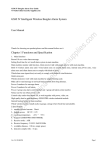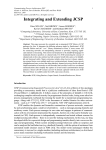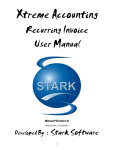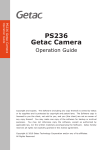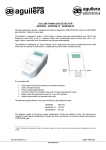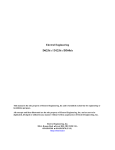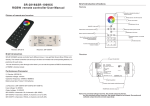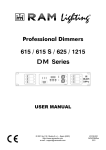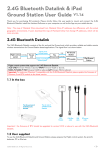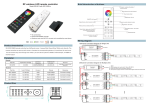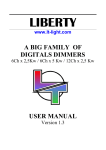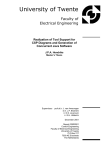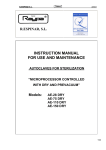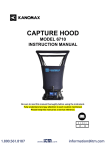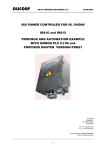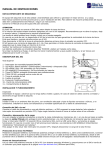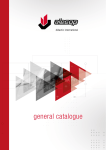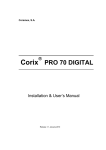Download D 40 K2 / D 66 K2 DMX
Transcript
D 40 K2 / D 66 K2 DMX User Manual General Index Page 1......................................................................................................................Introduction 2 2.................................................................................................. Easy to use 2 3............................................................................................................... Operating 4 3.1. Slow Preheat 3.2. Consigna .................................................................................................................. 4 3.3. Information display 3.4. Menu display 3.5. Test menu 3.6. 3.7. 3.8. ............................................................................................ 4 ........................................................................................... 5 ..................................................................................................... 5 ........................................................................................................... 6 3.5.1. DMX test ......................................................................................................... 6 3.5.2. Analog test 3.5.3. Version test ..................................................................................................... 7 3.5.4. Preset............................................................................................................... 8 3.5.5. Auto Test .......................................................................................................... 8 ................................................................................................. 6 Setup menu .......................................................................................... 9 3.6.1. Preheat 3.6.2. Response time ................................................................................... 9 3.6.3. DMX input channel .................................................................................. 10 3.6.4. Curve of response ....................................................................................... 11 3.6.5. Language ............................................................................................................ 12 Local control menu ........................................................................................... 9 ............................................................................................ 13 3.7.1. Control by pushers 3.7.2. Control by switches Programming menu .................................................................................. 13 ............................................................................... 13 .......................................................................................... 14 3.8.1. Programm selection .................................................................................. 14 3.8.2. Playing programs 3.8.3. Deleting programs ............................................................................................ 15 3.8.4. Modify or create programs .......................................................................... 15 .......................................................................... 14 4............................................................................................... Technical Features 4.1. 4.2. Electrical features 19 ...................................................................................... 19 4.1.1. Model D40 K2 DMX 4.1.2. Model D 66 K2 DMX ......................................................................................... 19 Mechanics Features .......................................................................... 19 ..................................................................................... 19 4.2.1. Model D40 K 2 DMX .......................................................................... 19 4.2.2. Model D 66 K2 DMX ......................................................................................... 20 1 1. Introduction The present document pretends to make a description of ther menus in the displays, with the objective to transmit the operation. Moreover its show the technical features. 2. Easy to use • DMX 512 signal control • 0/+10V Analogic control(Allows to operate with DMX simultaneous) • LED indicator per channel for output level • Power supply LED indicator • DMX input signal LED indicator • Microprocessed temperature control. • DMX buffer against lost of connection • Programmable protection against strong variations on output level. • Synchronization with the microprocessed, allowing to detect and filter noises of power supply. • 16x2 characters display for general information and control menus. • 4 buttons for menus, 1 reset control and button for channel. • Response curves. Linear, Quadratic. Quadratic inverse, , on/off. • Preheat level for all channels • Automatic Frequency Auto-adjust between 47 and 63 Hz. • Slow start with 4 seconds flange, allowing to start the dimmer with complete load. • Micropocessed refrigeration by forced air. • Monophasic, Triphasic operation, with one phase emergency operation. • Power device: 25A Triac for 33 kW and 44A for 54 kW model. • 0/100% Duty cycle. • Easy use by MENUS • Programs memories Possibility of 3 programs of 64 chases each one. Programation possibility by chases, with time between chases and pauses. • Informative viewer Allow to view in the display the more significative parameters and the power supply Frequency on real time 2 Languages The user can choice the informative messages languages, choosing between 4 languages banks. Setup Possibility to configurate these parameters. - 12/6 channels preheat - Time Response - DMX Channel - Language - Response Curve Local mode Control Possibility to control all channel with buttons - Pushers - Switches DMX Control Mode Possibility to control 12/6 channels by DMX Analog Control mode Possibility to control by analogic console (0-10V) 3 3. Operating 3.1. Slow Preheat Desde el encendido del equipo hasta que se visualiza la pantalla de información se realiza un incremente lento de la intensidad de todos los canales hasta llegar al nivel de precalentamiento configurado. 3.2. Levels During the viewing in the information display, the levle indicated will be the output value on each channel, the maximum level between DMX input and Analog input. If you need to control the dimmer with DMX or analog and is produced a connection lost, the last values will be reminded. In case you need to control in Local or Program mode, the DMX and Analog inputs, will be ignored. After to start the unit, the DMX or Analog external values will be zero, until the reception of new values. 4 3.3. Information display In a few seconds after to start the unit, the next message appears on animated type. * DIMMER v2.10 * XX CANALES XX will be the number of channel with dimmer software configurated. Few seconds after the display will show DMX: 10 PH: 10 % Rs: 200 ms 1x50 Hz Where DMX is the DMX configurated channel. PH is the preheat level in percentage. RS response time of dimmer against changes on level of channels, and 50 Hz, de supply frquency detected. Beside the frequency can appear 1x or 3x to indicate that the supply is monophe or thi phase. 3.4. Menu display When you push MENU, we access to dimmer menus 1-Test 2-Config 3-Local 4-Prog. Buttons: • ‘1’ Test of differents device systems. • ‘2’ Parameters configuration • ‘3’ Device control on local molde. • ‘4’ Configuration and playing with the personalized programs • ‘MENU’ return to the information display 5 3.5. Test Menu 1-DMX 2-An 3-Ver 4-Preset 5-Auto Buttons: • ‘1’ Test of all DMX channels • ‘2’ Test of analogic inputs. • ‘3’ Shows the last software version • ‘4’ Start with the default values in all parameters. • ‘5’ Lighting fix secuence for checking unit. • ‘MENU’ return to the information display. 3.5.1. DMX Test Ch: XX NIVEL: YYY % E-Salir <,> With this test, we can view the value in % of selected channel. This value is the same of configurated DMX channel, plus the number of channel - 1. Where XX is the DMX tested channel, YYY input level of selected channel on %. For example, if we have configurated the DMX channel 10 and we have selected CH 3, we are viewing the value of DMC channel number 12. Buttons: 3.5.2. • ‘MENU’ return to the initial display. • ‘<,>’ Increase or decrease in 1 the verified channel. verificando. • ‘1’..’12/6’: Select one channel.. Analogic Test Ch: XX NIVEL: YYY % E-Salir <,> With this test, we can view the value in % of the select ed channel. This value ies the input value of the analogic channel. Where XX is the Analogic trested channel, YYY is theinput channel value selected in %. 6 Buttons: • ‘MENU’ return to initial display. • ‘<,>’ increase or decrease in 1 the verified channel. • ‘1’..’12/6’: Select one channel. 3.5.3. Version Test DIMMER v2.10 E-Salir Show the software version in the dimmer. Buttons: • ‘MENU’ return to initial display. • ‘ENTER’ return to test menu. 7 3.5.4. Preset ESTAS SEGURO ? 1 - Si 6 – No 1 - No MUY SEGURO ? 6 - Si After to answer with positive form to the first 2 questions, all parameters change to default values in the dimmer test menus. *** BORRANDO *** After a delete seconds, we return to test menu 1-DMX 2-An 3-Ver 4-Preset 5-Auto 3.5.5. Auto Test *Test* E-Stop Chase: X M-Salir A lighting secuence with the 6/12 channel will starft in order to check the device. The control of this test is made similar than “ Program Play” 8 3.6. Setup Menu 3.6.1. Preheat Minimum level on 6/12 channel during all moment PRHT: XXX % E-Cambiar <,> Buttons: • ‘MENU’Return to initial display • ‘ENTER’ modify the value. Next displays is showed. • ‘<,>’ go to the next or previous configuration parameter. PRHT: XXX % E-Salir <,> Buttons: • ‘MENU’ Return to initial display, the changed parameter is not saved in memory. • ‘ENTER’ Go to previous display. The parameter are saved on memory. . • ‘<,>’ Increase or decrease the value. Continuous touch, change the value. 3.6.2. Response Time Time in miliseconds that the channels uese to pass for mimimum value to maximum against an instantaneous change of value. Respuesta: XXXX ms E-Cambiar <,> Buttons: • ‘MENU’ Return to initial display • ‘ENTER’ modify the value. Next display is showed. • ‘<,>’ pass to next or previous configuration parameter. 9 Respuesta: XXXX ms E-Salir <,> Buttons: • ‘MENU’ Return to initial display, the changed parameter is not saved in memory. • ‘ENTER’ Go to previous display. The parameter are saved on memory. . • ‘<,>’ Increase or decrease the value. Continuous touch, change the value. 3.6.3. DMX Input Channel Select with od 512 DMX channel will be assign to the firs DMX channelk. The rest of dimmer channels will be assigned consecutively. So the range of selected channel will be from 0 to 512 - 6 for 6 channel dimmer and from 0 to 512 - 12 for 12 channel model. DMX: E-Cambiar <,> Buttons: • ‘MENU’ Return to initial display. • ‘ENTER’ modify the value The next display is showed. • ‘<,>’ pass to the next or previous configuration parameter. DMX: E-Salir <,> Buttons: • ‘MENU’ Return to initial display, the changed parameter is not saved in memory. • ‘ENTER’ Go to previous display. The parameter are saved on memory. . • ‘<,>’ Increase or decrease the value. Continuous touch, change the value. 10 3.6.4. Response curve It selects the kind of response curve to be applied/assigned to the input. The kinds of curve are: - Lineal: channeloutput - Quadratic: BLUE - Quadratic inverse: ROSE - ON/OFF: change fron ON to OFF at 50% with a flange between 45% to 55% 300 250 200 150 100 50 0 0 50 100 150 200 250 300 -50 Picture 1 Curva: CCCCCC E-Cambiar <,> Buttons: • ‘MENU’ Return to information display. • ‘ENTER’ modify the value. The following display is showed • ‘<,>’ to go to the previous or next parameter of configuration. Curva: CCCCCC E-Salir <,> Buttons: • ‘MENU’ Return to initial display, the changed parameter is not saved in memory. • ‘ENTER’ Go to previous display. The parameter are saved on memory. . • ‘<,>’ To select the kind of curve to be applied. 11 3.6.5. Language Selection of which of the 4 available languages that will be used for all the dimmer displays. Idioma: E-Cambiar <,> Buttons: • ‘MENU’ return to the initial display. • ‘ENTER’ modify the value. The following display is showed. • ‘<,>’ To go to previous or next parameter of configuration Idioma: E-Salir <,> Buttons: • ‘MENU’ Return to initial display, the changed parameter is not saved in memory. • ‘ENTER’ Go to previous display. The parameter are saved on memory. . • ‘<,>’ To select the language between spanish, English, German ... 12 3.7. Local control menu Through this menu is possible to control the dimmer channel from the corresponding key of each channel. 1-Pulsador 2-Interruptor Buttons: • ‘MENU’ Return to initial display • ‘1’ Menu for pushers. • ‘2’ Menu switches 3.7.1. Control by pushers While getting pushed the key corresponding to the cha nnel desired, the channel output intensity will be the same to the level configurated according to the menu. NIVEL: NNN % E-Salir <,> Buttons: • ‘MENU’ Return to initial display • ‘<,>’ To modify the output level. • ‘E’ Output to the local control menu • ‘1’..’12/6’: To select the channel. 3.7.2. Control by switches One touch activates the channel desired, a touch disactivates it, the channel output intensity will be the same to the configurated level according to the menu NIVEL: NNN % E-Salir <,> Buttons: • ‘MENU’ Return to initial display. • ‘<,>’ To modify the output level. • ‘E’ Output to the local control menu • ‘1’..’12/6’: Select the channel 13 3.8. Programming Menu The programming allows to make lighting sequences, varying the response and intensity time of channel of dimmer, disposing of - 3 available memories to program - 64 chases for program - Each chase of program is compossed of the values of 6/12 channels, the response time and the time between chases. 1-Play 2-Program 3-Borrar Program Buttons: • ‘1’ To play a program previously saved. • ‘2’ To create or modify a lighting program • ‘3’ To delete one of the programs • ‘MENU’ return to the initial display 3.8.1. . Program selection Touching whatever of the 3 programming menu options, previous to the input in the selected option, it is necessary to indicate the program on which you desire to work, according to the next display showed. Programa: P E-Seleccion <,> Buttons 3.8.2. • ‘<,>’ Program selection. • ‘ENTER’ To enter to the option selected previously. Play, program or detele. • ‘MENU’ Return to the initial display Playing program Before beginning the reproduction, the chases used of the program selected are showed during some seconds XX CHASES USADOS Once showed the chases used, the following display appears during some seconds. 14 Prg.: P E-Stop Chase: CC M-Salir When you enter in PLAY, the reproduction of the sequence stored previous begins, where “P” is the selected program and CC is the number of chase that is being played. During the reproduction wwe disposes of Buttons: • ‘MENU’ To go out to the programming main menu • ‘ENTER’ Stop the reproduction. In this time is showed Prg.: P E-Play Chase: CC M-Salir Buttons: 3.8.3. • ‘MENU’ To go out to the programming main menu • ‘ENTER’ To reinitiate the execution of the program. Delete Program Once the program is selected, this one is erased according to the display. Programa: P Borrando 3.8.4. Modify or Create program Before beginning the program, the chases used of the program selected are showed during some seconds. XX CHASES USADOS Once showed the chases used, the following display appears during some seconds. : Pulsa MENU para ayuda de control Then, it is indicated that touching MENU, and only during the configuration of the channels, a help will appears in the display touching MENU CANAL-Editar Val <,>-Selecc.E-Sal 15 Channels edition After the display of help, it will appear: c-CH: n n+1 n+2 NV: 100% 100% 100% Where the c indicates the chase in which we are. n, n+1, n+2 Indicate the channels of the chase that we can modify and in the inferior line the value of the 3 channels. Buttons: • ‘MENU’ To view the help in display • ‘ENTER’ Save the program and go to the program menu • Teclas de canal ‘n’…’n+2’ Edit the value of the selected channel. • Tecla Down (<) Select 3 channels less to edit. In case of being in The channels 1,2 and 3, will go to the previous channel. In case of being In the first chase, we will go to the last chase. • Tecla Up (>) It select 3 channels more to edit. In case of being in the 3 last channels, edit the time of delay in ms of values of the chase. . . Example for 6 channels: 1-CH: 1 2 3 NV: 100% 100% 100% Pulse ‘>’ 1-CH: 4 5 6 NV: 100% 100% 100% Pulse ‘>’ 1 -Retard: E-Cambiar ms <,> To edit the value of channel 5, once in the second display of the previous series, push 5 In this moment, the value edit will twinkle and with the keys < and > we will could modify the value. 1-CH: 4 NV: 100% 5 6 47% 100% Buttons: • ‘MENU’ Has none effect • ‘ENTER’ Save the value and continue with the edition of the channels. 16 • ‘<’ y ‘>’ change the channel value. Continuous touch for the continuous change. Edition of the time of response After going to the 3 last channels in the display of “ EDITION CHANNELS” and continue again the display of configuration of response time will appears for the chase in which we are 1 -Retard: E-Cambiar ms <,> Buttons: • ‘MENU’ has none effect • ‘ENTER’ Change the value of the time of response • Tecla Down (<) Return to channel setup display • Tecla UP (>) Pass to the next display of the pause chase After pushing ENTER, we can change the value through this display 1 -Retard: E-Salir ms <,> Buttons: • ‘MENU’ Has none effect. • ‘ENTER’ save the value and continue with the edition of the channels. • ‘<’ y ‘>’ change the time value from 10 to 10 ms. Continuous pushing for continuous change. Pause time edition After going from delay time display, a display will appear with this pause time 1 -Pausa: E-Cambiar ms <,> Buttons: • ‘MENU’ Has none effect. • ‘ENTER’ Change the pause time value • Tecla Down (<) Return to display of response time configuration 17 • Tecla UP (>) Go to the next display of channel configuration of the next chase. If you are in the last chase, you pass to the first chase. After pushing ENTER we can change the value through the display 1 -Pausa: E-Salir ms <,> Buttons: • ‘MENU’ Has none effect • ‘ENTER’ Save the value and return to the display of view of value. • ‘<’ y ‘>’ Change the time value from 100 to 100 ms. Continuous pushing continuous change. Resume the sequence of program CONFIGURACIÓN DE CANALES CHASE n ? CONFIGURACIÓN DEL TIEMPO DE RESPUESTA CHASE n ? CONFIGURACIÓN DEL TIEMPO DE PAUSA CHASE n ? CONFIGURACIÓN DE CANALES CHASE n+1 ? CONFIGURACIÓN DEL TIEMPO DE RESPUESTA CHASE n+1 ? CONFIGURACIÓN DEL TIEMPO DE PAUSA CHASE n+1 18 Save program If touch ENTER in the channels edition display, the program will be saved in memory. Programa: n Grabando After a recording seconds, it will pass to program main menu 4. Technical Features 4.1. Electrical features 4.1.1. D 40 K2 Model (Schukos 12 channels) Tri phase connection: 33KW Mono phase connection: 11KW Triacs de 25A 4.1.2. D 66 K2 DMX Model (12 channels) Tri phase connection: 55KW Mono phase connection: 18KW Triacs of 40A 4.2. Mechanics features 4.2.1. D 40 K2 Model (12 channels) High: 177mm Wide: 442mm Deep: 412mm Weight: 18Kg 4.2.2. D 66 K2 DMX Model (12 channels) High: 132mm Wide: 442mm Deep: 412mm Weight 25Kg 19 Equipson, S.A. www.equipson.es [email protected]





















